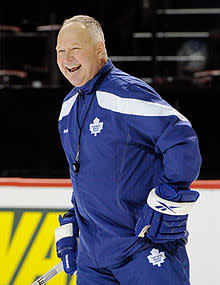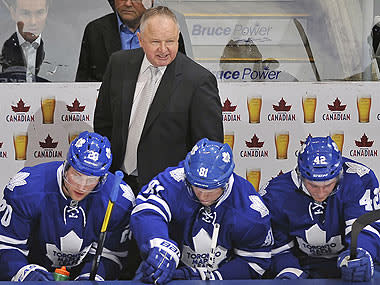Toronto Maple Leafs coach Randy Carlyle takes on big task with little room for error
TORONTO – Randy Carlyle replaced Ron Wilson with 18 games to go, and general manager Brian Burke gave two reasons for making the coaching change when he did: One, Carlyle gave the Toronto Maple Leafs a chance to salvage the season. Two, if they missed the playoffs, Carlyle would get a head start on next season.
Two games later, Carlyle walked into the interview room at Air Canada Centre after a 5-4 loss to the Boston Bruins talking about the "process here with this hockey club."
Salvaging this season would be a minor miracle. The Leafs lost for the 11th time in 13 games Tuesday night. And not only did they fail to improve their position – they're still five points out of a playoff spot, with four teams to hurdle at 12th place in the East – they lost second-leading scorer Joffrey Lupul to an upper-body injury. He will miss one game. At least.
This is not going to be fixed by the jolt of a firing, a 3-1 victory over the last-place Montreal Canadiens and two days of two-hour, training camp-type practices. During the second intermission against the Bruins, an NHL scout who has watched the Leafs often this season was asked if he saw anything different. He said no.
The Leafs could skate. The Leafs could score. But the scout said the Leafs were still a team with a goaltender, Jonas Gustavsson, who looked "out of whack" and a defense that looked out to lunch in front of him.
There were breakdowns, Bruins left wide open. Leading scorer Phil Kessel had a trademark night: a goal, an assist and a minus-2 rating. His line gave up two goals on the same shift in the second period.
"Tonight," Carlyle said, "was just another indication of the amount of work that's necessary on the defensive side of it."
Since the coaching change, there has been a lot of talk about truculence – that vocabulary word Burke used when he arrived in Toronto in November of 2008 but hasn't applied much when building his roster.
In his news conference Saturday morning in Montreal, Burke said the one area in which he and Wilson differed slightly was toughness. He said he liked his hockey a little rougher than Wilson did. He said Carlyle fit his philosophy.
People looked back at the tough teams Carlyle had with the Anaheim Ducks, including the 2007 Stanley Cup champion that Burke helped build. With the reigning Cup champs in town, people looked at the big, bad Bruins as another model.
But truculence and toughness aren't enough.
The Leafs called up enforcer Jay Rosehill from the minors, and he squared off with Bruins heavyweight Shawn Thornton in the second period. It was a big-time bout, with heavy punches thrown in the middle of the rink, right on the Leafs logo.
Alternate captain Colby Armstrong got into a scrap in the second period, too. He saw Adam McQuaid coming, then went after Dennis Seidenberg.
So what?
Rosehill picked a fight after Bruins winger Jordan Caron blew past Leafs defenseman Luke Schenn and set up a Boston goal. Armstrong ended up on his knees, bleeding, and left a red trail as he left the ice. He didn't return. Carlyle said he had an "issue with his nose."
"If the fighting does occur, so be it," Carlyle said. "But the compete level is what's going to be the thing that's going to turn this hockey club around."
By compete level, Carlyle isn't talking about competing hard. He expects his players to compete hard. He expects them to be aggressive. He expects them to hit. That's basic hockey.
He's talking about competing the right way. Stepping inside your man. Using your legs and your body instead of just your arms. Being strong on your stick. When he brought up examples, he brought up names like Nicklas Lidstrom and Scott Niedermayer – defensemen who aren't bruisers, but defensemen who have won the Norris Trophy and the Stanley Cup.
"Winning your fair share of 1-on-1 battles is a skill set," Carlyle said. "It has to be developed with this hockey club. Expectations are that we've got to win more of our 50-50 battles or our 1-on-1 battles for the puck."
Ultimately it's up to Burke to build a more truculent team for Carlyle. A few of the Leafs can throw their weight around more than they do now: Schenn, Dion Phaneuf, Mike Komisarek. But for the most part, for now, Carlyle can't coach his players to be tough. He can't make them what they're not. He can only draw out the best of what they have.
"When I played with him, we were fortunate enough to have a very tough team," said Thornton, who played in Anaheim in 2007 before going to Boston. "I think our team here is built that way. I know that he will make players play outside of their comfort zone, I suppose, or you don't play. I think he'll be good for them over there."
The Leafs have 16 games to go – realistically, 16 games for Carlyle to coach every inch of the ice, harp on every little detail, see what he has and see what he needs this summer. He said professional players all have gone through change in their careers and should have the sports IQ to absorb information quickly, and you've got to think how the players react will be an important part of his evaluation.
It doesn't take a scout to see what the Leafs need most: a No. 1 goaltender and a No. 1 centerman – the elite, difference-making talents that are difficult to acquire unless you draft and develop them yourself.
But the Leafs have a young foundation, including defensemen who are still developing: Jake Gardiner (21), Schenn (22), Cody Franson (24), Carl Gunnarsson (25) and Phaneuf (26). While Carlyle has been teaching the big-picture systems, new assistant coach Dave Farrish has already been teaching things like body positioning down low.
There is no time to waste. Carlyle was asked if he had taken five or 10 seconds to appreciate his first game at the ACC.
"No," he said quickly. "It's frustrating when you score four goals and you lose the hockey game. That's as simple as I can put it."
If only it were so simple to solve.


